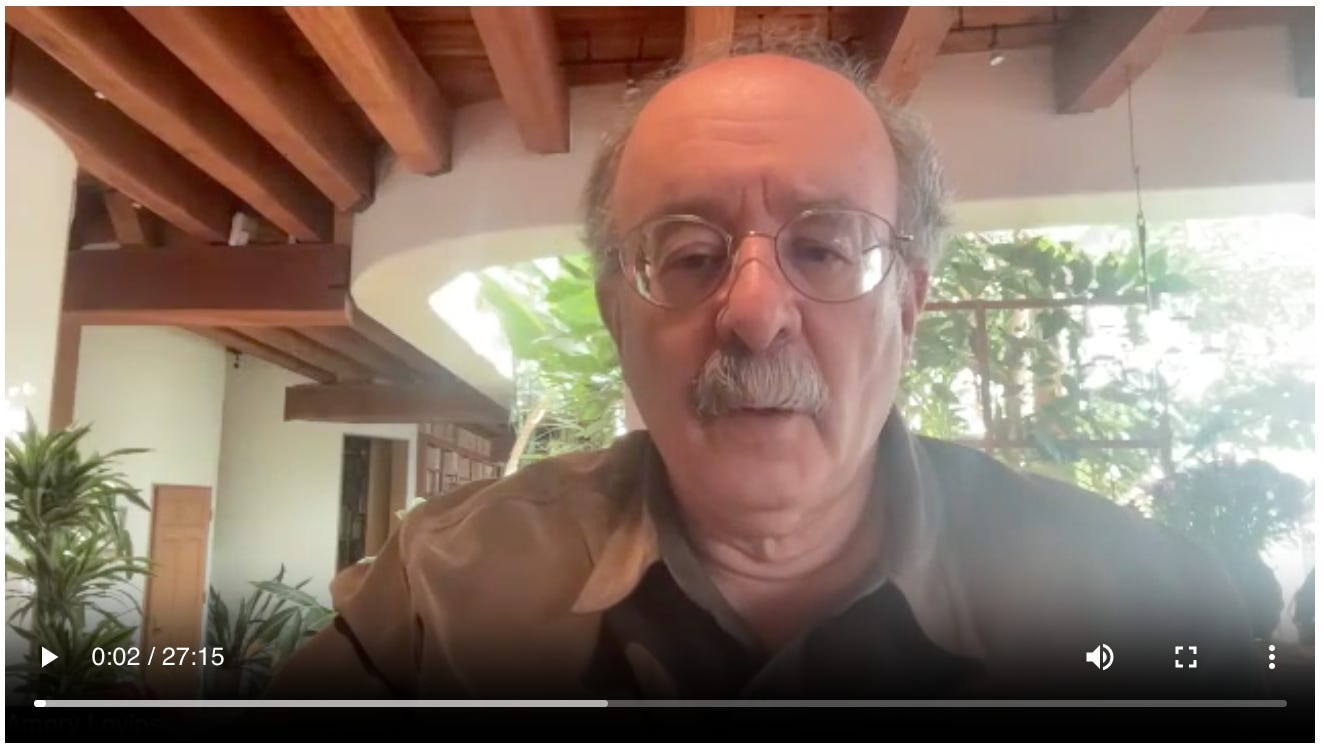Transcript to the Hot Globe Interview with Amory Lovins, the World's Most Pragmatic Climate Visionary:
"Applied Hope," The positive impact of the Ukraine War, Radical energy efficiency, The New LNG battle, and a take-down of nuclear power for those who should know better
First, thanks to so many Hot Globe free- and new subscribers for Upgrading to Paid with our end of 2023 appeal, “It’s a Wild and Wonderful World.” That’s what makes Hot Globe’s unusual interviews and climate analysis possible. Here’s a chance to start the New Year feeling good:
Next week we return to Lahaina, Maui, Hawaii, for an optimistic message for the new year from the brilliant, encyclopedic and irrepressible official archeologist of the Island, Dr. Janet Six.
But many of you wanted to read the transcript of our talk with Amory Lovins, co-founder of the Rocky Mountain Institute and a climate visionary whose ideas are now widely adopted throughout the world. If you want to change the future, it is pretty much helpful to check in with Lovins first. So here’s the transcript. (I mean, who has time to view a 30 minute video, unless it’s Succession or White Lotus!)
Amory Lovins in his “radically efficient” house in Old Snowmass, Colorado, 2200m feet up, where this winter he enjoyed his 42nd consecutive crop of bananas in the enclosed solarium behind him.
HOT GLOBE: Hot Globe here with Amory Lovins. I'm going to say the legendary Amory Lovins, co-founder of the Rocky Mountain Institute, energy consultant to corporations, states and governments, author of Soft Energy Paths, Natural Capitalism with Hunter Lovins and Paul Hawken, and most recently, Reinventing Fire. Amory pretty much invented the energy efficiency revolution.
Amory, to address the climate crisis and decarbonize the world, people talk endlessly about solar, wind, batteries, better grid, but you say saved energy is the world's biggest energy source today.
AMORY LOVINS: Oh, yeah. It's a lot bigger than oil. Of course, the renewables revolution is extraordinary and wonderful. But let's not forget that efficient use is about half the historic decarbonization in the world and at least half of the prospective decarbonization. So we shouldn't forget about the demand side of using all forms of energy efficiently and in a timely fashion. That's generally the cheapest, fastest thing to do. It has its own set of barriers. There’s 60 or 80 obstacles to using energy in a way that saves money, but each one can be turned into a business opportunity.
HOT GLOBE: You've gone from the soft path—energy efficiency, renewables--which was a great concept adopted by the entire world but now you’re ramping it up with the concept of radical energy efficiency--
AMORY LOVINS: Oh, I've been doing radical energy efficiency for about a half century, but particularly now that we figured out and demonstrated it as whole systems for multiple benefits, not as isolated little parts for single benefits. People are starting to realize pretty widely you can do that with buildings, but it turns out you could do the same thing with factories, equipment, vehicles, anything that uses energy and resources. This turns out to make the whole energy efficiency resource several times bigger, but also cheaper and often with increasing returns, just like renewables. That is, the more you buy, the cheaper it gets. So you buy more, so it gets cheaper.
HOT GLOBE: Why haven't we moved on that part of the equation as much? Is it less sexy, not so much ribbon-cutting for the politicians?
AMORY LOVINS: For starters, the only place I know it's taught is by Joel Swisher and me at Stanford. It's not in any standard engineering textbook. It's not in any government forecast or industry forecast or any climate model. So naturally, it hasn't spread nearly as far or fast as it could. And actually, it could probably be spread, I suspect, by images and memes through social media. You don't have to go back to school and learn a bunch of new theory. If you just see how it's done, it becomes obvious. Let me give you a few good examples of how this works. Let's start with what you can see behind me. I'm talking from our passive solar banana farm home and office 2200m up in the Rocky Mountains near Aspen, where it used to go to -44 C, -47 F on occasion. It doesn't anymore, thanks to global weirding, but it's still gets awfully cold here. And we've seen 39 days of continuous midwinter clouds. But banana crop #41 is ripening behind me in a jungle with 100 odd kinds of other tropical plants. And by the way, there's no heating system, and it was cheaper to build. The reason it's cheaper to build is that you save more on construction costs, leaving out the heating system.
Keep reading with a 7-day free trial
Subscribe to HOT GLOBE to keep reading this post and get 7 days of free access to the full post archives.


